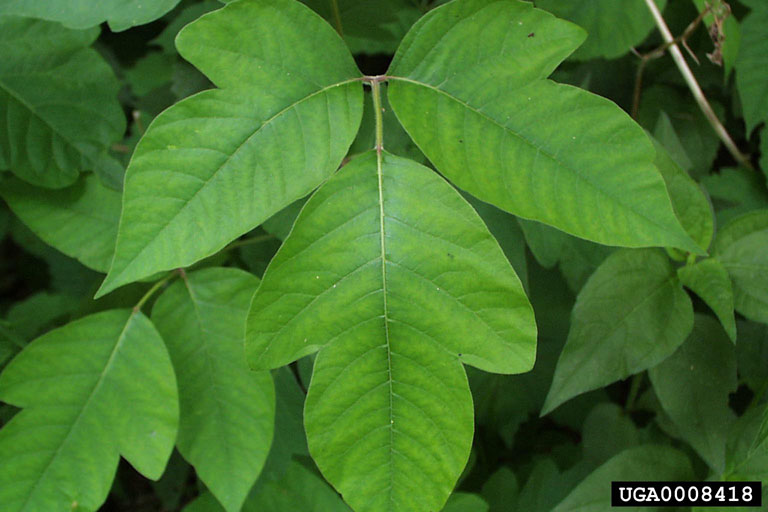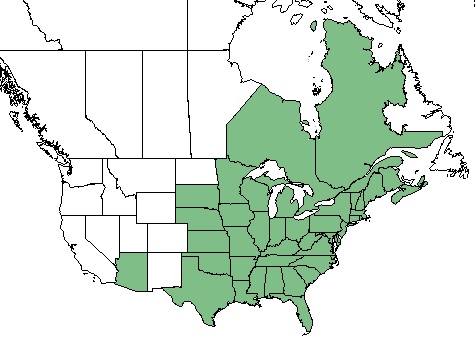Difference between revisions of "Toxicodendron radicans"
Rwagner914 (talk | contribs) |
|||
| Line 17: | Line 17: | ||
| range_map_caption = Natural range of ''Toxicodendron radicans'' from USDA NRCS [https://plants.usda.gov/core/profile?symbol=TORAR Plants Database]. | | range_map_caption = Natural range of ''Toxicodendron radicans'' from USDA NRCS [https://plants.usda.gov/core/profile?symbol=TORAR Plants Database]. | ||
}} | }} | ||
| + | Common Name(s): Midwestern poison ivy<ref name="Weakley 2015">Weakley A. S.(2015). Flora of the Southern and Mid-Atlantic States. Chapel Hill, NC: University of North Carolina Herbarium.</ref>, eastern poison ivy<ref name="Weakley 2015"/><ref name="USDA">USDA, NRCS. (2016). The PLANTS Database (http://plants.usda.gov, 20 December 2017). National Plant Data Team, Greensboro, NC 27401-4901 USA.</ref> | ||
| + | |||
==Taxonomic Notes== | ==Taxonomic Notes== | ||
| − | ==Description== | + | Varieties: ''T. radicans'' var. ''negundo''; ''T. radicans'' var. ''pubens''; ''T. radicans'' var. ''radicans'' <ref name="Weakley 2015"/> |
| − | <!-- Basic life history facts such as annual/perrenial, monoecious/dioecious, root morphology, seed type, etc. --> | + | |
| + | ==Description== <!-- Basic life history facts such as annual/perrenial, monoecious/dioecious, root morphology, seed type, etc. --> | ||
| + | ''Toxicodendron radicans'' is a dioecious perennial that grows in the form of a forb/herb, shrub, subshrub, or vine.<ref name="USDA"/> Leaves are deciduous, alternate, trifoliate, ovate with dentate margins and can change to a deep orange or red color in the fall. It requires partial to full shade. All parts of this plant are considered poisonous. Oils on the plant contain urushiol, a severe skin irritant, which can cause severe skin redness, itching, swelling and blistering following direct or indirect contact.<ref name="Ladybird">Plant database: ''Toxicodendron radicans''. (20 December 2017).Lady Bird Johnson Wildflower Center. URL: https://www.wildflower.org/plants/result.php?id_plant=TORA2</ref> | ||
| + | |||
==Distribution== | ==Distribution== | ||
| + | It can be found from Texas north to South Dakota and Minnesota and in all of the states eastward. It has also been reported in southern Arizona and the Ontario and Quebec provinces of Canada.<ref name="USDA"/> | ||
| + | |||
==Ecology== | ==Ecology== | ||
===Habitat=== <!--Natural communities, human disturbed habitats, topography, hydrology, soils, light, fire regime requirements for removal of competition, etc.--> | ===Habitat=== <!--Natural communities, human disturbed habitats, topography, hydrology, soils, light, fire regime requirements for removal of competition, etc.--> | ||
| − | < | + | ''T. radicans'' is found throughout a wide range of habitats including mesic forests, rock outcrops, open areas, disturbed areas, xeric limestone sites, swamp forests, brackish marshes, bottomlands, maritime forests.<ref name="Weakley 2015"/> |
| + | |||
| + | ===Phenology=== <!--Timing off flowering, fruiting, seed dispersal, and environmental triggers. Cite PanFlora website if appropriate: http://www.gilnelson.com/PanFlora/ --> | ||
| + | Flowering occurs from March to May with fruits appearing in August through October.<ref name="Weakley 2015"/><ref name="PanFlora">Nelson G. (20 December 2017) PanFlora. Retrieved from gilnelson.com/PanFlora/</ref> Flowers can contain colors of white, green and/or brown. Fruits are amber in color and 0.25 in (6.4 mm) in diameter.<ref name="Ladybird"/> | ||
<!--===Seed dispersal===--> | <!--===Seed dispersal===--> | ||
<!--===Seed bank and germination===--> | <!--===Seed bank and germination===--> | ||
<!--===Fire ecology===--> <!--Fire tolerance, fire dependence, adaptive fire responses--> | <!--===Fire ecology===--> <!--Fire tolerance, fire dependence, adaptive fire responses--> | ||
| − | <!--===Pollination===--> | + | <!--===Pollination===--> |
| − | + | ||
| + | ===Use by animals=== <!--Herbivory, granivory, insect hosting, etc.--> | ||
| + | ''T. radicans'' attracts butterflies and is highly resistant to deer herbivory.<ref name="Ladybird"/> It comprises 10-25% of the diet of large mammals and 5-10% for small mammals and terrestrial birds.<ref name="USDA"/> | ||
<!--==Diseases and parasites==--> | <!--==Diseases and parasites==--> | ||
Revision as of 13:24, 20 December 2017
| Toxicodendron radicans | |
|---|---|

| |
| Photo by Paul Wray, Iowa State University, Bugwood.org hosted at Forestryimages.org | |
| Scientific classification | |
| Kingdom: | Plantae |
| Division: | Magnoliophyta - Flowering plants |
| Class: | Magnoliopsida - Dicots |
| Order: | Sapindales |
| Family: | Anacardiaceae |
| Genus: | Toxicodendron |
| Species: | T. radicans |
| Binomial name | |
| Toxicodendron radicanss (L.) Kuntze | |

| |
| Natural range of Toxicodendron radicans from USDA NRCS Plants Database. | |
Common Name(s): Midwestern poison ivy[1], eastern poison ivy[1][2]
Contents
Taxonomic Notes
Varieties: T. radicans var. negundo; T. radicans var. pubens; T. radicans var. radicans [1]
Description
Toxicodendron radicans is a dioecious perennial that grows in the form of a forb/herb, shrub, subshrub, or vine.[2] Leaves are deciduous, alternate, trifoliate, ovate with dentate margins and can change to a deep orange or red color in the fall. It requires partial to full shade. All parts of this plant are considered poisonous. Oils on the plant contain urushiol, a severe skin irritant, which can cause severe skin redness, itching, swelling and blistering following direct or indirect contact.[3]
Distribution
It can be found from Texas north to South Dakota and Minnesota and in all of the states eastward. It has also been reported in southern Arizona and the Ontario and Quebec provinces of Canada.[2]
Ecology
Habitat
T. radicans is found throughout a wide range of habitats including mesic forests, rock outcrops, open areas, disturbed areas, xeric limestone sites, swamp forests, brackish marshes, bottomlands, maritime forests.[1]
Phenology
Flowering occurs from March to May with fruits appearing in August through October.[1][4] Flowers can contain colors of white, green and/or brown. Fruits are amber in color and 0.25 in (6.4 mm) in diameter.[3]
Use by animals
T. radicans attracts butterflies and is highly resistant to deer herbivory.[3] It comprises 10-25% of the diet of large mammals and 5-10% for small mammals and terrestrial birds.[2]
Conservation and Management
Cultivation and restoration
Photo Gallery
References and notes
- ↑ 1.0 1.1 1.2 1.3 1.4 Weakley A. S.(2015). Flora of the Southern and Mid-Atlantic States. Chapel Hill, NC: University of North Carolina Herbarium.
- ↑ 2.0 2.1 2.2 2.3 USDA, NRCS. (2016). The PLANTS Database (http://plants.usda.gov, 20 December 2017). National Plant Data Team, Greensboro, NC 27401-4901 USA.
- ↑ 3.0 3.1 3.2 Plant database: Toxicodendron radicans. (20 December 2017).Lady Bird Johnson Wildflower Center. URL: https://www.wildflower.org/plants/result.php?id_plant=TORA2
- ↑ Nelson G. (20 December 2017) PanFlora. Retrieved from gilnelson.com/PanFlora/